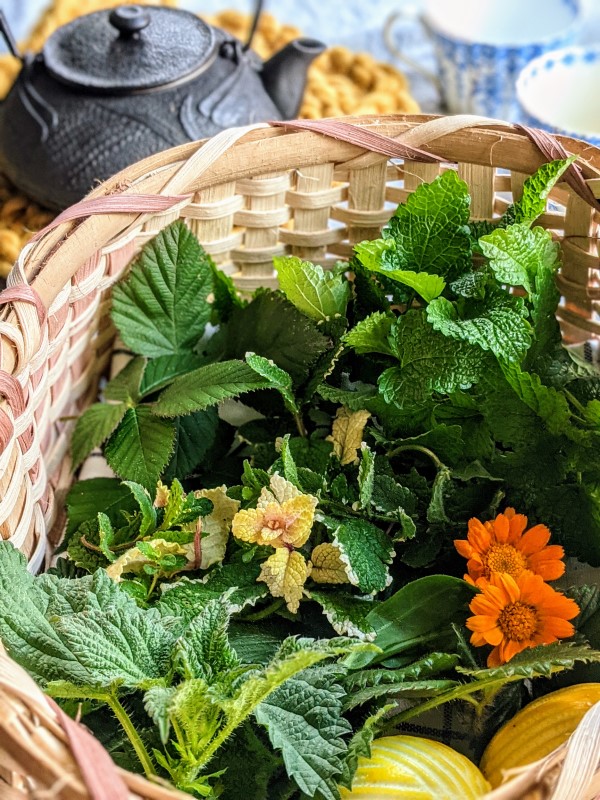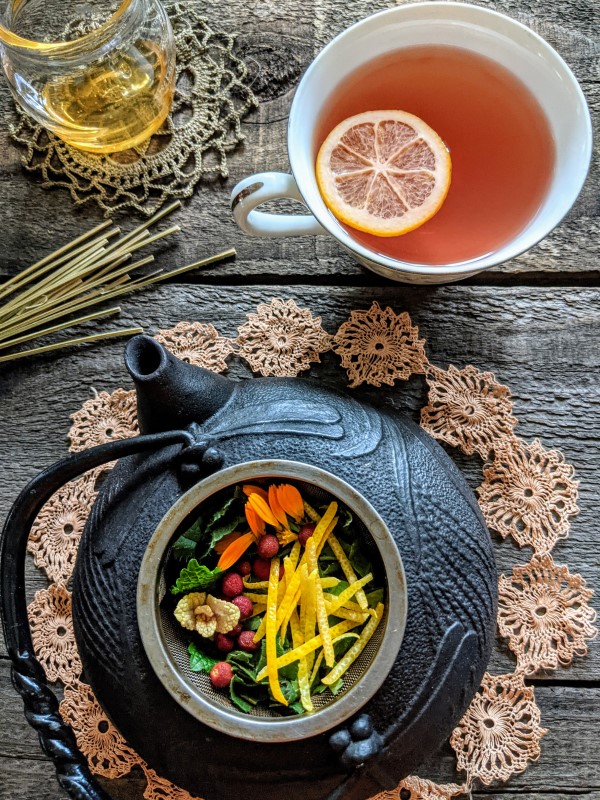Winter Sunshine Tea
By Alison Steele
After a month of rich, sweet and savory holiday cooking, our ovens (and bodies!) may be needing a break. Introducing a daily herbal infusion in place of an afternoon bake is an easy way to bring our bodies back into balance. January is the month when the bright green of most tea herbs are peeking out from underneath leaf fall and woody stems. Summer scorched mint is laden with new growth, and spindly nettles are young and tender. We don’t think to harvest berry leaves when the fruits are in season, but now the leaves look enticing for a quick pot of cleansing and nourishing tea from the winter garden.
With all the holiday hubbub keeping me inside, I needed a quick dash around the garden for a breath of fresh air and to see what I could find growing. In a matter of minutes, I had my basket filled with afternoon tea. A quick rinse in the newly filled rain barrel, a shake or two, a gentle crush between fingertips to release vital essential oils and the herbs are ready for infusing.
Lemon balm, nettles, strawberry and raspberry leaves, peppermint, spearmint, pineapple mint, lemons, lavender tips, and pineapple sage blossoms are thriving in the cold and rain with little help from anyone. These will do fine for afternoon tea along with some madrone berries the kids collected a few days earlier. Never underestimate the power of fresh infusions for delivering much needed vitamins and minerals right when they are needed.

Melissa Officinalis (Melissa means “honeybee” in Greek) is native to southern Europe and was called “honey leaf” by the Greeks due to its lemony scent and flavor as well as its ability to attract pollinators when in bloom. Lemon Balm is also understandably called the “sunshine herb” by some herbalists. It acts as a nervine, lifting spirits while relieving tension and relaxing the nervous system. Honey Leaf has also been used to ease digestion, upset stomach, headaches, and a restless night’s sleep. Could there be a more perfect herb for a January tea?
Urtica Dioica or Stinging Nettle never disappoints. By the time you are tired of taming this common weed, it rests a while revealing its small dark green shoots again in the winter. Loaded with A, C, K, and several B vitamins, this prolific superfood is a winter staple in the kitchen. We dry it for tea and eat it fresh in soups all the way through Spring until it flowers in midsummer. Our fiddler friend uses it in fresh pesto when there’s no summer basil to be found. Use gloves if you don’t enjoy the sting of the nettle!
Strawberry, blackberry, and raspberry leaves contain the same bioactive compounds found in their fruits! Berry leaves are an excellent way to add antioxidants to your diet, along with anti-inflammatory and antimicrobial properties. They aid our systems by quenching excessive internal heat and stopping the overgrowth of unhealthy microorganisms in our gut.
Berries or edible flower petals are a colorful addition to the kettle. I can always count on Calendula in the winter for its cheery smiling heads of tangerine colored petals. We collected the dark red madrone berries from a tree that had fallen in the last storm, leaving the lower berries for the forest animals. There’s nothing like a splash of red to bring a pot of tea to life! Wintery pineapple sage blossoms are also stunning in a tea blend.
Lastly, I harvested a Meyer Lemon. Our small tree woke from near death after the lightning fires and gave us two golden lemons this winter! I use every part of these winter gifts, shaving the zest before slicing it razor thin to dry along the top shelves of our tall warm cottage ceilings. Lemon zest can be added to everything from pot pies to salad dressings. It’s easily dried for year round herbal infusions, salt blends, and sock drawer sachets.
Winter Sunshine Infusion Serves 2
4 T lemon balm, roughly chopped or gently crushed
4 T pineapple mint
4 T nettles
2 T strawberry leaves, sliced thin
2 T blackberry leaves
2 T fresh lemon zest
2 T crushed madrone berries
calendula petals or pineapple sage blossoms
Hickory syrup or local raw honey (optional)
16 oz boiling water
An infusion is nothing more than fresh leaves, flowers, buds, berries, seeds, and aromatics steeped in hot water. Roughly chop, slice, or gently crush your tea ingredients. Pack the kettle strainer to the brim with fresh tea greens, flowers, berries, and lemon zest. Swirl boiling water slowly over the top of the strainer, cover and let steep for at least 5 minutes. Carefully, pour into a tea cup and recycle the first pour back over the infused herbs. Now your flavors and colors are ready for a sip, and maybe a small bit of hickory syrup or honey. Stir gently. Dried lavender stems harvested before the rains work beautifully. Lift the cup to your face and breathe. Sit down and breathe deep. Feel the warm cup in your hands. Taste the raw lemony mint tea and imagine the strength it’s imparting to your body. Pause, if only for a minute or two, and let the sunshine in!
A native of Virginia, Alison Steele lives with her husband, two children, and cat in Boulder Creek where she raises quail, chickens, fruit trees, vegetables, and herbs. Alison plays banjo and sings in Sugar by the Pound
Featured photo of Winter Sunshine Infusion Tea by Alison Steele
The San Lorenzo Valley Post is your essential guide to life in the Santa Cruz Mountains. We're dedicated to delivering the latest news, events, and stories that matter to our community. From local government to schools, from environmental issues to the arts, we're committed to providing comprehensive and unbiased coverage. We believe in the power of community journalism and strive to be a platform for diverse voices.





